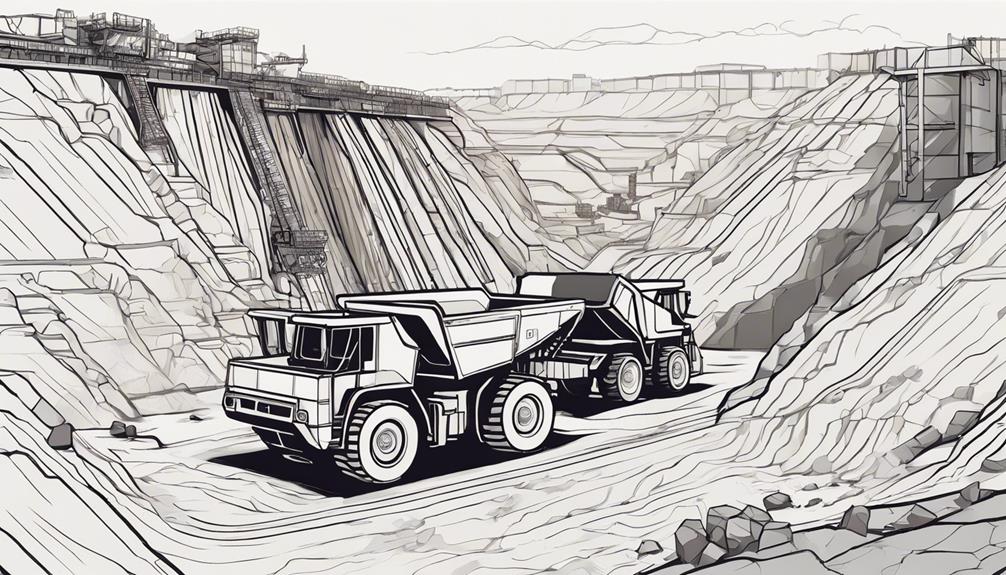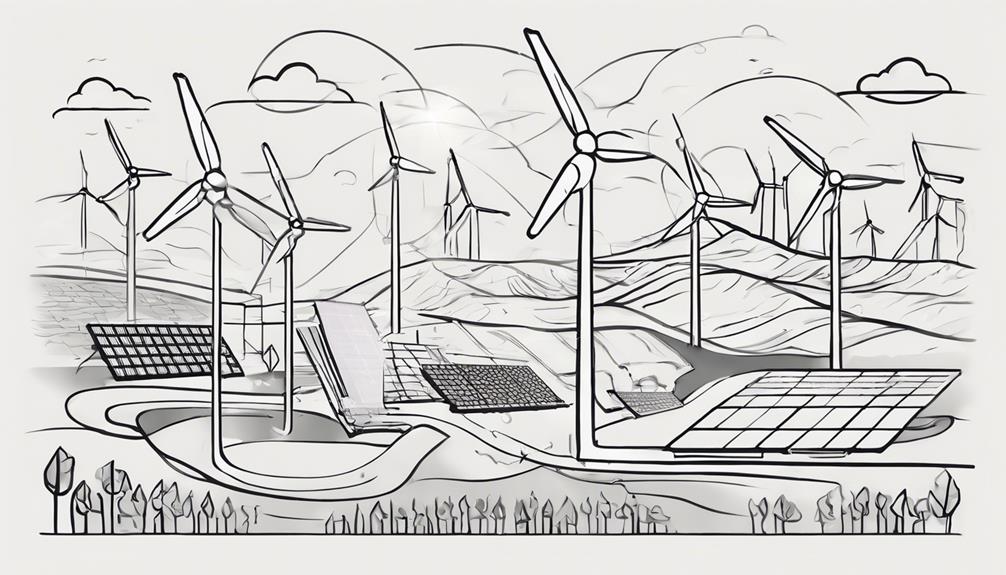Natural resources, the cornerstone of sustenance for life on our planet, hold a critical role in shaping the very fabric of our existence. From the air we breathe to the minerals that construct our modern conveniences, these elements are the bedrock of civilization. However, the intricate balance between exploitation and preservation of these resources is a delicate dance that humanity must navigate with prudence. In understanding the true essence of natural resources lies the key to unlocking a sustainable future for generations to come.
Key Takeaways
- Natural resources like water, soil, minerals, and renewable energy are crucial for sustaining life.
- Responsible management of resources is essential to meet growing global demands sustainably.
- Transitioning to renewable energy sources is vital for reducing environmental impact and achieving self-sufficiency.
- Wildlife conservation and biodiversity preservation are necessary for ecosystem balance and resilience.
Definition of Natural Resources

What fundamental characteristics define natural resources and their significance in the environment and economy? Natural resources encompass a wide array of materials or substances that are naturally occurring and are essential for the sustenance of life. These resources can be broadly classified into two main categories: renewable resources and non-renewable resources. Renewable resources, such as sunlight and wind, are naturally replenished and play a crucial role in maintaining ecological balance. On the other hand, non-renewable resources like fossil fuels and minerals are finite in quantity and take millions of years to form.
The economic gain derived from natural resources is substantial, as they serve as the foundation for various industries and energy production. However, their exploitation must be balanced with sustainable management practices to prevent depletion and environmental degradation. Conservation efforts are indispensable to ensure the availability of these resources for future generations. In essence, natural resources are not only vital for economic prosperity but also for environmental conservation and the well-being of all living organisms on Earth.
Types of Natural Resources
A diverse range of natural resources exists, each serving distinct purposes and playing crucial roles in sustaining life on Earth. Some of the key types of natural resources include:
- Coal: A non-renewable natural resource formed over millions of years from decayed plants; it is a significant source of energy used in electricity generation and industrial processes.
- Oil: Another non-renewable resource crucial for transportation, heating, and the production of various materials like plastics.
- Natural Gas: Like oil, natural gas is a non-renewable resource used for heating, cooking, electricity generation, and as a fuel for vehicles.
- Renewable Energy: Includes resources like wind, solar, and hydropower, which are replenished naturally and provide sustainable alternatives to fossil fuels.
- Mineral Resources: Encompass a wide range of elements like iron, copper, and bauxite, essential for manufacturing goods ranging from electronics to construction materials.
Understanding the distinctions between these various types of natural resources is vital for effective resource management and conservation efforts.
Importance of Water Resources

Highlighting the fundamental significance of water resources in sustaining ecological balance and human prosperity is crucial due to the limited availability of usable water on Earth. With less than 1% of the planet's water suitable for human consumption, the importance of conserving water resources becomes evident. The projected 400% increase in global water demand for manufacturing by 2050 emphasizes the necessity for efficient water management practices to ensure sustainability. In the U.S., ranking third in water consumption globally, the significance of implementing sustainable water usage strategies is paramount. Surface water, the source of 63% of public water supply in the U.S., underscores the critical need for effective surface water management to maintain water resource sustainability. Moreover, the escalating issue of groundwater depletion in various U.S. regions highlights the urgency of adopting sound groundwater management techniques. Through prudent conservation and sustainable management practices, the vital role of water resources in supporting both ecosystems and human well-being can be preserved for future generations.
Significance of Soil Resources
The pivotal role of soil resources in sustaining agricultural productivity and ecosystem stability cannot be understated, serving as the foundation for food production and biodiversity conservation.
- Soil resources are essential for agriculture, providing nutrients and support for plant growth.
- Healthy soils are crucial for food production, as they help retain water and prevent erosion.
- Soil biodiversity enhances ecosystem stability and nutrient cycling, vital for sustaining life.
- Degraded soils can lead to reduced crop yields, impacting food security and livelihoods.
- Soil conservation practices like crop rotation and cover cropping help maintain soil health and productivity.
Soil resources play a critical role in agriculture by acting as a reservoir of nutrients necessary for plant growth. Moreover, they aid in erosion prevention and water retention, which are essential for sustainable food production. The diversity of organisms found in soil contributes to ecosystem resilience and nutrient recycling processes, enabling the maintenance of life-supporting functions. Therefore, implementing soil conservation practices is imperative to preserve soil health and ensure the continued productivity of agricultural systems.
Role of Mineral Resources

Playing a fundamental role in modern industrial processes and manufacturing sectors, mineral resources are indispensable for the production of everyday necessities and infrastructure. Metals like iron and copper are vital for various industrial processes, enabling the manufacturing of products such as cars, electronics, and buildings that are essential for societal functioning. The global economy heavily relies on the extraction and utilization of mineral resources, with minerals like bauxite being crucial for producing aluminum, a key material in construction, transportation, and packaging industries.
To ensure the continuous availability of these resources, responsible mining practices are imperative. By implementing sustainable access strategies, we can mitigate the depletion of mineral reserves and safeguard these valuable resources for future generations. It is essential for countries to prioritize sustainable mining practices to balance the economic benefits derived from mineral resources with the need to preserve environmental integrity and ensure long-term availability.
Impact of Forest Resources
Delineating the intricate interplay between human activities and forest ecosystems, the impact of forest resources encompasses a wide array of environmental, economic, and social implications.
- Forest resources provide habitat for diverse plant and animal species, supporting biodiversity.
- Forests contribute to carbon sequestration, helping mitigate climate change by absorbing CO2.
- Forests are a source of timber and wood products, essential for construction and manufacturing.
- Deforestation threatens forest resources, leading to habitat loss, soil erosion, and decreased water quality.
- Sustainable forestry practices, like selective logging and reforestation, are crucial for maintaining forest resources for future generations.
Ensuring the preservation of forest resources is vital not only for the myriad of species that call forests home but also for the global climate. By balancing the extraction of resources with conservation efforts, we can harness the benefits of forests sustainably while safeguarding their long-term health and productivity.
Contribution of Energy Resources

Human society's energy demands play a pivotal role in shaping not only economic activities but also environmental sustainability and resource management. The U.S., comprising just 4.4% of the global population, consumes a disproportionate 18% of the world's primary energy. While renewable energy is rapidly growing and is projected to match coal and natural gas by 2040, the nation's energy production fell short of meeting 11% of its requirements in 2014, highlighting a dependence on imports. Despite leading in natural gas production, the U.S. still imports more natural gas than it produces. Embracing renewable resources and recycled materials not only fosters self-sufficiency but also aids in curbing emissions, contributing positively to environmental preservation. As the energy landscape evolves, transitioning towards cleaner and more sustainable sources is crucial for reducing reliance on imports and mitigating the environmental impact of traditional energy sources like coal and natural gas.
Value of Wildlife Resources
Wildlife resources play a crucial role in maintaining ecosystem balance through services like pollination and pest control. Strategies to preserve biodiversity are essential for enhancing ecosystem resilience and adaptability to environmental changes. Furthermore, the benefits of ecotourism highlight the economic value of wildlife resources and their significance in supporting local livelihoods.
Wildlife Conservation Importance
The preservation of wildlife species is fundamental to maintaining ecological balance and ensuring the continued availability of vital resources for human sustenance and well-being.
- Wildlife conservation is crucial as biodiversity provides essential resources like food, building materials, and medicines.
- The current extinction rates are 1,000 times the natural rate, emphasizing the need to protect wildlife.
- Protecting biodiversity ensures varied food sources, ecosystem balance, and prevents disruption of food chains.
- Efforts to prevent species extinction, such as abolishing harmful hunting practices, are vital for wildlife conservation.
- Conservation initiatives focus on protecting wildlife habitats through parks and preserves.
Biodiversity Preservation Strategies
Utilizing strategic biodiversity preservation strategies is paramount in safeguarding the invaluable resources provided by wildlife ecosystems. Biodiversity preservation is essential due to the current extinction rates exceeding natural levels by over 1,000 times. Protecting wildlife habitats is crucial as it ensures varied food sources and contributes to maintaining ecosystem balance. Conservation efforts play a significant role in preventing disruptions in food chains and sustaining diverse species. Initiatives focus on abolishing harmful hunting practices to prevent species extinction. Establishing parks and preserves are part of wildlife conservation measures aimed at protecting habitats and promoting the overall well-being of wildlife populations. By implementing these strategies, we can work towards maintaining the delicate balance of our ecosystems and safeguarding the diversity of life on Earth.
Ecotourism Benefits Wildlife
Enhancing the economic and conservation value of wildlife resources, ecotourism plays a pivotal role in promoting sustainable development and fostering environmental stewardship.
- Ecotourism contributes over $600 billion annually to the global economy, benefiting local communities and wildlife conservation efforts.
- Wildlife resources attract millions of tourists worldwide, supporting conservation projects and sustainable development.
- Protected wildlife areas generate revenue through ecotourism, funding conservation programs and protecting endangered species.
- Wildlife-based tourism provides employment opportunities for local communities, promoting economic growth and environmental stewardship.
- Responsible ecotourism practices help raise awareness about wildlife conservation, fostering a sense of appreciation and respect for natural habitats.
Utilization of Agricultural Resources
Optimizing the utilization of agricultural resources is paramount in ensuring sustainable food production systems. Agricultural resources, including fertile land, water, seeds, and livestock, are vital for producing food, fiber, and fuel for human consumption. To maximize the efficiency of these resources, sustainable practices such as crop rotation, organic farming, and integrated pest management are employed. Crop rotation helps maintain soil fertility and reduces the reliance on chemical fertilizers, while organic farming minimizes the use of synthetic pesticides and promotes biodiversity. Integrated pest management combines biological, cultural, and physical methods to control pests effectively, reducing the need for chemical interventions.
Preservation of Biodiversity Resources

The conservation of biodiversity resources is a critical aspect of ensuring the long-term sustainability of ecosystems and the well-being of human societies. Biodiversity resources provide essential food, building materials, and medicinal sources for human well-being. Current extinction rates are 1,000 times the natural rate, emphasizing the urgent need to protect biodiversity. Protecting biodiversity ensures a variety of food sources, maintains ecosystem balance, and prevents disruptions in food chains. Conservation efforts focus on preventing species extinction by abolishing harmful hunting practices and protecting wildlife habitats. Initiatives like creating parks and preserves aim to safeguard biodiversity resources and prevent further species loss. To protect biodiversity, it is crucial to implement sustainable practices and policies that prioritize the preservation of species and their habitats, ultimately benefiting both the environment and humanity.
Sustainable Management of Natural Resources
Sustainable management of natural resources is essential for ensuring their longevity and availability for future generations. By implementing resource conservation methods, we can protect biodiversity, preserve the environment, and support local communities. The benefits of sustainability extend beyond environmental protection, contributing to economic growth, job creation, and the overall well-being of society.
Resource Conservation Methods
Implementing effective resource conservation methods is crucial for the sustainable management of natural resources.
- Sustainable management involves practices like recycling, reforestation, and waste reduction.
- Conservation methods such as water reclamation, energy efficiency, and protected areas help preserve resources for future generations.
- Sustainable agriculture techniques like crop rotation and organic farming minimize environmental impact.
- Sustainable forestry practices promote biodiversity through selective logging and tree planting.
- Responsible fishing practices, marine protected areas, and aquaculture aid in conserving marine ecosystems and resources.
Benefits of Sustainability
Effective management practices for natural resources through sustainability initiatives play a crucial role in ensuring long-term environmental health and resource availability for future generations. The sustainable use of natural resources not only protects natural resources but also promotes environmental preservation. Conservation efforts aid in safeguarding biodiversity, ecosystems, and natural habitats, fostering a balance for sustainable resource management. Moreover, this approach generates job opportunities, bolsters local economies, and enhances community well-being. By integrating sustainable practices like renewable energy adoption and responsible forestry, environmental impacts are reduced, and resilience is promoted. Striking a balance between economic development and environmental preservation through sustainable resource management is essential for a prosperous and healthy future for all.
| Benefits of Sustainability | |
|---|---|
| Protecting natural resources | Job opportunities |
| Environmental preservation | Resource management |
| Sustainable use of natural | Conservation efforts |
Frequently Asked Questions
Why Is It Important to Protect Our Natural Resources?
Protecting natural resources is crucial for ensuring environmental conservation and sustainability. By safeguarding biodiversity and ecosystem health, we mitigate resource depletion and combat climate change. Conservation efforts today directly impact the well-being of future generations. Economically, responsible resource management is a global responsibility with far-reaching implications. Embracing renewable energy sources and conservation initiatives are essential steps toward preserving our natural resources for a sustainable future.
Why Are Resources Important?
Resources are crucial due to their impact on conservation strategies, economic benefits, and sustainable practices. Renewable energy and conservation efforts are key in managing resources with global implications. Biodiversity preservation and ecosystem balance are vital for combating climate change and preventing resource depletion. Understanding the importance of resources is fundamental in fostering responsible resource management and ensuring a sustainable future for all.
Why Are Natural Resources Important to Development?
Natural resources are vital to development due to their role in fostering economic growth, supporting infrastructure development, and ensuring energy security. Resource scarcity underscores the importance of sustainable management practices to maintain long-term environmental sustainability. Moreover, natural resources drive innovation and technological advancements in various industries, enhancing productivity and competitiveness. Harnessing these resources effectively is essential for achieving sustainable development goals and improving the quality of life for populations worldwide.
What Are the 4 Types of Natural Resources?
The four types of natural resources can be categorized based on their renewability and ownership: renewable resources like solar energy and wind, non-renewable resources such as fossil fuels and minerals, individual resources, community-owned resources, national resources, and international resources. Understanding these distinctions is fundamental for effective management, conservation efforts, and sustainable development practices. These resources play a vital role in shaping economic dynamics, environmental sustainability, and global distribution networks.
Conclusion
In conclusion, natural resources are essential elements that support life on Earth, playing a crucial role in sustaining ecosystems, economies, and societies. The preservation and sustainable management of these resources are imperative for the well-being of current and future generations. Without proper conservation efforts, the depletion of natural resources could lead to devastating consequences for the environment and human civilization. It is therefore essential to prioritize the responsible utilization and protection of these valuable resources.
